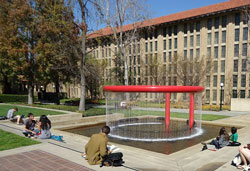Acupuncture needles inserted in the body produce a rapid sedative effect that stimulates multiple regions of the brain. Photo courtesy of Shutterstock
Lying down on an exam table, spreading your arms and legs apart, and closing your eyes as fine needles are inserted into your skin sounds counterintuitive to pain relief. The ultra-thin stainless-steel acupuncture needles are strategically placed into your skin at acupuncture points to evoke "deqi" sensations that can lead to a relaxed and healthier you. The tiny sensations caused by the pricks on your skin actually activate the nervous system and the brain, but how does this all work?
The “qi” sensation that is widely discussed in acupuncture is produced when a needle is inserted. The aching, tingling sensation generates responses in different brain regions as acupoints are needled. In fact, specific acupuncture points have distinct deqi characteristics that have a consistent and unique ability to stimulate specific brain regions.
Stimulating acupuncture points leads to overlapping brain responses in a number of cortical and subcortical brain regions. This includes the insula, thalamus, anterior cingulate cortex and primary and secondary somatosensory cortices — all part of the sensorimotor cortical network, according to Medscape. At the same time, there is a deactivation in the limbic-paralimbic-neocortical network, which includes the medial prefrontal cortex, caudate, amygdala, posterior cingulate cortex, and parahippocampus. These brain areas are associated with a pain matrix that is responsible for modulating both the sensation of pain and affective pain perception.
In the YouTube video, “This Is Your Brain On Acupuncture,” user James Whittle, an acupuncturist in Asheville, N.C., shows the difference in brain activity during superficial needling and deep needling. Unlike superficial needling, deep needling has been shown to be more effective than the superficial one for the treatment of pain associated with myofascial (pressure) on trigger (sensitive) points. However, the superficial technique is more apt for treating areas with potential risk of significant adverse effects, such as lungs and large blood vessels.
A group of researchers in the video sought to delve deeper into the effects of both techniques on the brain. First, an MRI scan was taken of the brain at base line, meaning at rest, to observe the activity taking place. Then, the research team scanned the brain when the needles were inserted into the participant’s body using superficial and deep needling techniques, respectively.
In the superficial needling MRI, the researchers found there was an increase in blood flow in front of the brain. This is just the brain’s normal response to the needle being lightly inserted. The deqi sensation in deep needling was actually found to lead to a deactivation in areas of the brain further back. Scientific analysis has shown deqi can deactivate areas within the brain that are associated with the processing of pain. “That reinforces the idea that something quite special is happening, something unique to acupuncture, something physiological,” said Dr. George Lewith of the University of Southampton in the video.
MRI images of two acupuncture techniques.
MRI images of brain activity in superficial needling (L) and deep needling (R).
A 2005 study published in the journal NeuroImage found acupuncture increased activity in a different brain area called the insula, which is part of the cerebral cortex. Although the researchers admit they don’t know what this activity means, it indicates acupuncture does have some real effect on the brain. "What we have demonstrated is that acupuncture is partially modulated by expectation but is probably also modulated by a real treatment effect," Lewith said in the press release.
These studies add evidence that the already proven beneficial practice in Traditional Chinese Medicine does have a mysterious, unexplained effect on the brain. Acupuncture does cause an activation/deactivation of cerebral functional regions. However, there are those who believe much of the relief of acupuncture is simply due to a placebo effect.
In the U.S., there are more than 3,000 physicians who integrate acupuncture into their clinical practice, according to the Cleveland Clinic. Currently, chiropractors and acupuncturists are struggling to gain acceptance from the health insurance industry since acupuncture’s efficacy has yet to be confirmed in scientific studies. Traditional Chinese Medicine, such as acupuncture, still has a long way to go in the U.S. to be considered in the same caliber as other Western medical treatments.











